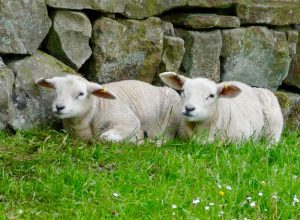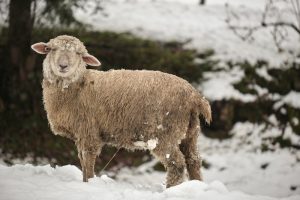Do Sheep Need Shelter From the Rain?
If you’re planning to invest in a flock of sheep, it’s important to know how to properly care for them and provide them with adequate shelter when need be. Different types of animals can each be affected differently by the rain, heat, and cold, so understanding the needs of sheep before you buy will enable you to provide good care from the beginning.
So, do sheep need shelter from the rain? Sheep will need a shelter they can escape to when it is raining. They may seek shelter in a run-in shed, a barn, or even under a tree. Rain can cause sheep to become chilled and can contribute to negative health conditions like rain rot.
While sheep are known to be hardy, they can be affected by rain in negative ways. If you’re knowledgeable about how rain affects sheep, you’ll be able to take the necessary precautions to ensure that your sheep are comfortable and safe. Keep reading to learn more about how to care for sheep in the rain.
How Does Rain Affect Sheep?
There are different variables to keep in mind when determining how the rain may affect your sheep. Here are some things to consider when it comes to leaving your sheep out in the rain:
Rain Has Different Effects on Different Breeds of Sheep
There are two basic types of sheep; hair sheep and wool sheep. Hair sheep are sheep that have a coat much like that of other animals. Their coats don’t require shearing and they grow and shed their hair throughout the year. Sheep breeds that fall into this category include Dorpers, St. Croix, Wiltshire Horn, Royal White, and West African Dwarf sheep. These sheep breeds are more likely to be used for their meat rather than their wool.
Wool sheep are the stereotypical sheep that grow the thick wool fleece. These sheep require sheering at least once a year to remove the heavy wool coat and to maintain general health and hygiene. Popular wool sheep breeds include Leicester Longwool, Shetland, Cheviot, Hampshire, and Lincoln sheep. These sheep breeds are mainly used to produce wool that can be turned into many different products.
Rain can affect each type of sheep differently. The wool on wool sheep has water-proof qualities that enable the water to roll off of the wool. Wool sheep can also do well in cold and wet environments since their fleece will insulate them from the cold. Hair sheep may not be as hardy as wool sheep when it comes to surviving in the rain and cold. Their coats don’t protect them as well from the water and moisture, and once drenched, they can easily become chilled. While both types of sheep are hardy animals, inclement and extreme weather can cause both sheep to eventually become soaked and cold if they’re out in the elements for too long.
Sheep Will Naturally Seek Shelter From Rain
 Most sheep are used to living outside 24/7. Their natural instincts help them to survive, even when conditions can be severe. Sheep will naturally seek shelter from rain or bad weather by finding something that will protect them from the wind and rain. If there are trees in the pasture or big rocks, the sheep may stand under the trees or stand so that the rock is blocking the wind.
Most sheep are used to living outside 24/7. Their natural instincts help them to survive, even when conditions can be severe. Sheep will naturally seek shelter from rain or bad weather by finding something that will protect them from the wind and rain. If there are trees in the pasture or big rocks, the sheep may stand under the trees or stand so that the rock is blocking the wind.
To stay warm, sheep will shiver and huddle together. Whether you have a run-in shelter or a windbreak out in your pasture, you may notice that all your sheep will huddle together in the shelter or on one side of the windbreak. This herd mentality enables the sheep to keep surviving even in harsh conditions.
If your sheep have a pasture that provides tree cover and windbreak objects, that may be all your sheep need to stay protected from the rain. If the pasture is more open, it’s a good idea to put up a run-in shelter where the sheep can escape from the elements.
Besides livestock, did you know that poultry needs shelter as well? To learn more, check out my article Do Ducks Need a Coop: What You Need to Know.
Rain Can Cause Skin Conditions in Sheep
Whether you’re a human or a sheep, excessive moisture can cause unwanted skin conditions that can affect your health. When it comes to caring for your sheep, giving them an escape from the rain can go a long way in taking care of their skin. While sheep fleece may be water-resistant, once the water has seeped through, the wool can hold the moisture to the body.
A common skin condition that sheep face is Dermatophilosis; some other names for this condition include rain rot, rain scald, and mud fever. Sheep aren’t the only ones who get Dermatophilosis, but also cattle, horses, and goats. Dermatophilosis is caused by bacteria that can be absorbed into the skin with moisture. Once absorbed, the bacteria can cause the skin to be scabby and irritated, causing the livestock discomfort.
If your area has had a particularly wet season, even if your sheep have an adequate shelter you should still check them for signs of Dermatophilosis. The most recognizable characteristic is that it will look like your animal has a bunch of scabs in the same area. Luckily, Dermatophilosis is relatively easy to treat. I usually use an Iodine solution or apple cider vinegar over the affected area every day until the area clears up.
Besides skin conditions, did you know that your sheep, along with other livestock, can also get fleas? Fleas on sheep can be treated much like fleas on goats. To learn more, check out my article Do Goats Get Fleas? Essential Goat Care.
Is Your Sheep Freshly Shorn?
While I mentioned above that wool sheep tend to be more resistant to rain and cold, once a wool sheep is shorn, it can become easily susceptible to rain chill and even hypothermia if out in bad conditions. This is why it’s recommended to shear sheep in the summer when the sheep can be relieved from the heat with a shorter coat but still avoid the cold that comes with the changing seasons.
If the weather is to be more chilly and your sheep is recently sheared, you can help your sheep avoid hypothermia by providing them with adequate shelters like a run-in shed or a barn. Also, provide them with more hay than usual, as eating helps sheep produce energy and body heat.
If your shorn sheep is struggling with the cold, it may appear more lethargic than normal. In these situations, it’s important to get the sheep to a warm and dry area. Some people will even blanket their sheep in these situations to provide an extra bit of warmth and protection.
Do you have Pregnant or Newborn Sheep in Your Flock?
Sheep are generally low-maintenance livestock that requires little monitoring when it comes to pregnancies and births; however, pregnant sheep and young lambs can be more vulnerable to the wet and cold. These sheep have a higher risk of getting hypothermia and dealing with stress from the cold.
When there is rain in the forecast, it can be best to keep the pregnant sheep and young lambs in a dry barn and provide them with plenty of food and warm bedding. This will help to keep them warm and avoid getting soaked and chilled.
Frequently Asked Questions
 Can Sheep Survive in the Snow?
Can Sheep Survive in the Snow?
Sheep can survive in many different weather conditions, including snow. If your sheep are out in a pasture, snow can cover the normal forage your sheep rely on. While sheep can dig through the snow to find grass, it’s also important to provide your sheep with extra food during snow coverings. Your sheep will also require adequate shelter where they can escape the cold and the wet to rest and stay warm. Barns and run-in sheds can make great winter shelters for your sheep.
Can Sheep Get Cold?
Sheep can get cold. While hair sheep may be more susceptible to the cold, wool sheep can do much better in these conditions since their thick fleeces can insulate body heat. It is found, however, that if temperatures drop below 0° Fahrenheit (-17° Celcius), wool sheep can start to suffer from cold stress and hypothermia. In these conditions, the safest thing to do is to keep your sheep in a barn where they have dry bedding and plenty of hay.
How Do I Tell If My Sheep Has Hypothermia?
Hypothermia is when your sheep’s body temperature drops below normal and the vital organs start shutting down. The normal body temperature for a sheep is 101° to 103.8°F. (38° to 40° C) If your sheep’s body temperature drops below 100°F (37.8°C), they are starting to suffer from hypothermia. Visible signs your sheep may have hypothermia include lethargy behavior, like laying down or moving slow, and appendages feeling cold to the touch.
Properly caring for your livestock can increase longevity and guarantee a higher return on your animals. Savvy Farm Life has many articles dedicated to answering your questions about livestock and poultry care. Check out these articles below:

